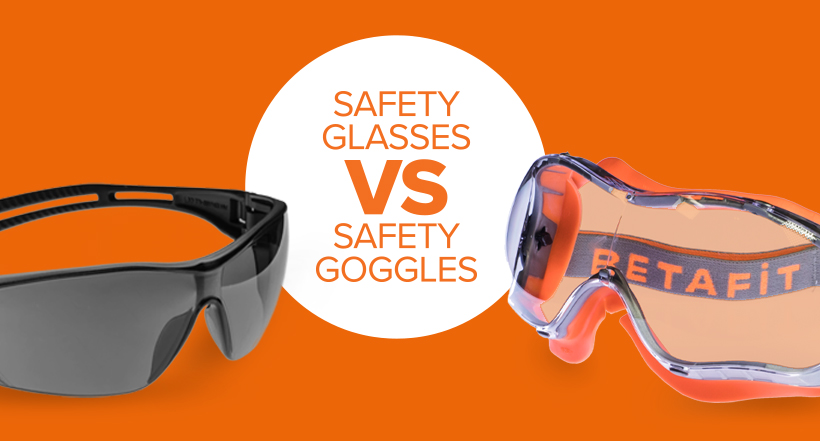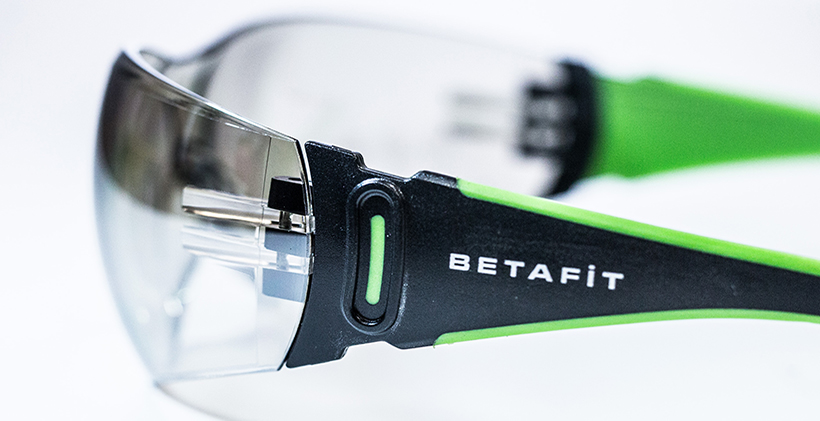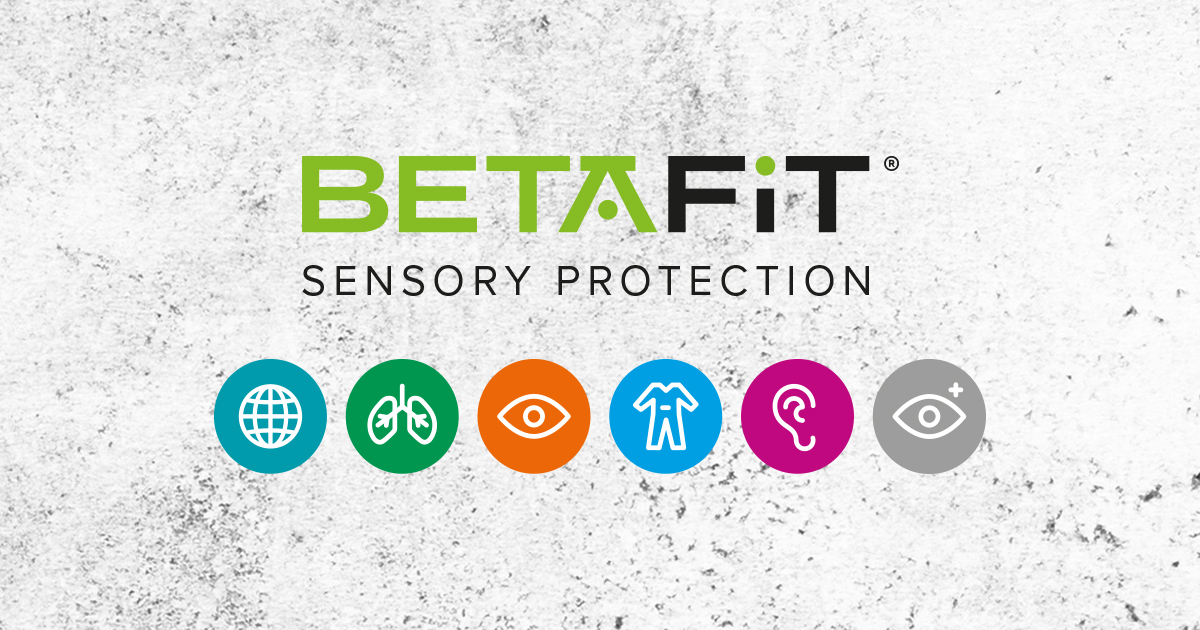
Eyes cannot be replaced. And in the industrial workplace, there are many different hazards that can lead to short-term or long-term damage to a person’s eyes. Safety glasses or safety goggles are protective glasses that protect the eyes from damage.
This is why Safety Eyewear is an essential part of the range of Personal Protective Equipment (PPE) available. Safety eye goggles or safety glasses must be provided by employers where necessary, to meet workplace safety standards outlined in Regulation (EU) 2016/425.
Safety Goggle glasses and Safety Glasses and are the main types of Safety Eyewear that employees will wear. This article is to clarify the differences between each, as well as some information on protective glasses in general.
To start with, what is Safety Eyewear?
Safety Eyewear is a form of PPE designed to protect or enclose the area surrounding the eye so that particulates, liquids or chemicals are prevented from harming the eye.
To be approved for use as “Safety” Eyewear, safety glasses, safety goggles and safety over-specs must be tested according to the European Regulation EN 166.
The main areas of this standard relate to the Optical Class and the Mechanical Strength of the eyewear, but there are also additional areas that can be tested, such as those relating to the Lens Filter properties and High Temperature Impact Protection. We go into further detail in our Safety Eyewear Ultimate Guide if you would like more information on these different property types for safety goggle glasses & safety specs.
This standard (EN 166) is considered as the minimum requirement for all safety eyewear, and certified eyewear must have the Certification Mark, or CE symbol, marked on it.
Safety Glasses:
Safety Glasses are a simple yet effective type of protective eyewear. The variety of styles available means they can be used by almost anyone and multiple types of protective coatings for the lenses means they can provide the required protection against many different hazards.
Key features to look for include the following.
Lens size: Quite simply, the size of the lens will make a big difference in the size of the area protected when worn; a larger lens will cover and protect the wearer more. But there is more than just the size, unless you need over glasses safety glasses to fit over your specs!
Lens shape: The effectiveness of the protection will be affected by the shape of the lens, and the closer fitting the lens is to the wearers face, the better the eyewear will protect from hazards. Most Safety Eyewear will have a “wrap-around” lens; the lens is concave and follows the general shape of the wearers face.
More advanced Safety glasses will take this further and the edges of the lens are angled back even further towards the wearers face, minimising the space between the eyewear and the face. The lens shape can also affect the field of vision, so be careful to use eyewear that creates minimal obstruction or “blind spots” when being worn.

Optical Clarity of Lens: Another element that can affect the wearer’s vision is the quality of the optical clarity. Class 1 optical clarity is the highest quality and means it is safe for the eyewear to be worn “continuously” without harming the eyes.
Class 2 is suitable for intermittent use, while the lowest quality, Class 3, is only suitable for occasional use and should not be worn for any lengthened period of time.
Lens protective properties: There are many protective properties lenses can have, and you can read about these in our “Safety Eyewear standards explained” article. To cover these briefly though, you can find lenses that provide the following protection.
- Anti-Scratch – protects from lens surface damage, maintaining the optical clarity.
- Anti-Mist/Anti-Fog – prevents the lens from misting/fogging to keep vision clear.
- Anti-Glare (EN172) – reduces sun-glare, common for eyewear worn outdoors.
- Welding filters (EN169) – To varying degrees, these provide protection from welding and related activities.
- Ultraviolet (UV) filters (EN170) – provides protection from exposure to UV.
Mechanical Strength: This refers to the level of impact protection the eyewear can withstand. The maximum protection Safety Glasses can provide is Low Energy Impact rating “F”, which will resist a 6mm, 0.86g ball travelling at 45m/s. Both the lens and the side-arms must be tested, and the eyewear will be rated according to the lowest protection level either achieve.
Side-arm style: Although Safety Eyewear is primarily concerned about protecting the eyes, by choosing a style that has wider side-arms, you can also increase the protection to the temple area. The relevance of this is, of course, dependent on the environment in which they are worn, but is worth considering if the option is available to you.

Over-Spectacles: Safety over-glasses safety specs is a specific style of Safety Glasses, designed to be worn over the top of prescription eyewear. This is because most Prescription eyewear doesn’t meet the required safety standards and so can’t be used as a replacement to Safety eyewear.
However, having “2-in-1” Prescription Safety eyewear is becoming more available and will be worth the extra cost in the relevant circumstances. The limitation of using over-glasses safety glasses is that they aren’t as widely available in the range of lenses that standard Safety Glasses are.
What are safety goggles?
There are two main differences that are most apparent between Safety Glasses and Safety Goggles. Firstly, protective glasses (goggles) are held to the wearers face using an elasticated strap running around the back of the head, as opposed to the side-arms on Glasses.
Secondly, protective safety goggles will have a soft inner seal, often foam or rubber, to seal the gap between the lens and the wearer’s face.
These differences immediately offer added protection in the following ways.
- The impact protection of safety goggles can be higher, up to Medium Energy Impact rating “B” (Resists a 6mm, 0.86g ball travelling at 120m/s). For an even higher rating you will need to look at Face Shields.
- The face-fitting seal will provide added protection against airborne particles, and also protect the eyes from liquid, or chemical, splash. Safety Glasses will have gaps around the lens that mean this level of protection can’t be provided.

Other features to look for on protective safety eye goggles:
Ventilation: As protective goggles have an inner seal, this can mean that airflow is limited around the lens which can then cause misting and limit vision. To avoid this, many goggle glasses will have some kind of “ventilation” built-in, mostly around the side or top of the goggle frame.
Direct vents are open, uncovered vents to allow airflow, but this compromises the protection against splash and airborne particles. Indirect vents are mostly covered vents, designed to allow airflow but block liquid splash from entering through the vents.
The preferred way to prevent misting though is to use safety goggles that have an Anti-Mist coating on the lens, so that protection isn’t compromised through the use of vents.
Optical Clarity: This is the same for safety goggles as it is for Glasses, and we recommend using goggle glasses with an Optical Clarity Class 1 rating.
Size and Shape: Take note also of the size and shape of the lens and frame, such that the design won’t impair the field of vision when being worn. It is likely that the environment where they will be worn will also help you decide what style/size goggles you need.
Similar to Over-specs, you may also need to check whether other eyewear can be worn under the protective goggle glasses.
Lens properties: There isn’t the same range of lenses available on safety goggles as there is on Glasses, but you will still be able to look for options like Anti-Mist, ventilation, etc.
Wearing with other PPE:
Another thing to bear in mind when choosing whether to use eye goggles or Glasses, is what other PPE will need to be worn at the same time? It could be that the side-arms of Safety Glasses affect the performance of Earmuffs, but then could the Earmuffs be changed for Ear Plugs instead? Or if a Respiratory Mask is being worn, will that affect the size of safety goggle glasses that you can wear?
As with all areas concerning safety, the circumstances and surrounding environment must be one of the key factors in determining which type of Safety Eyewear you need. Being aware of the differences in safety eyewear will help you make a more informed decision on PPE for your employees.

Need more information on the Safety Eyewear and eye goggle glasses for your workplace? Contact us today on 08455 444 000 or email [email protected]
Written by the Technical Team at BETAFIT PPE LTD.
